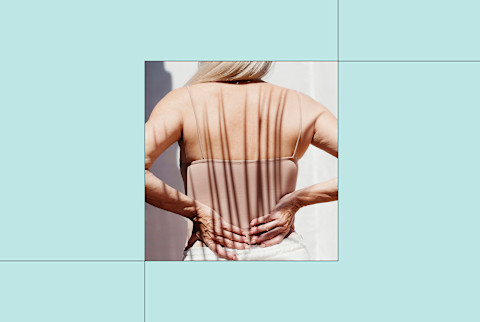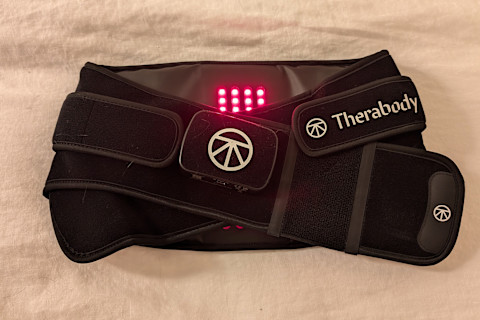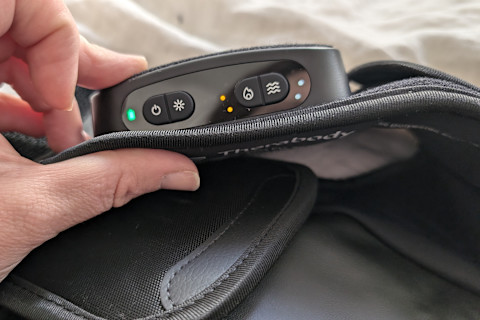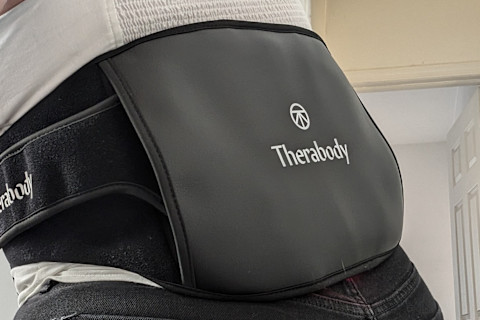Struggling With Back Pain? I Tested A Wearable LED Light To See If It Helped

At least 619 million people globally suffer from back pain—and I've been one of them for the last decade. In my early 20s, I became a cycling fanatic who lacked a well-rounded movement routine. I'd take two spin classes back-to-back, and failed to integrate strength training. Ultimately, it caused a lower back injury that's been plaguing me ever since.
And this isn't just a small ache. When my lower back hurts, the waves of pain can be severe enough that I have to lie down on the ground (sometimes even in the office).
As a result, I've been on the hunt for a back pain treatment that actually works—but research shows there isn't much. An estimated one in ten non-interventional protocols can relieve back pain. So when the Therabody Thermback LED promised a solution, I was skeptical. But after almost a month of testing, I can officially say my skepticism is gone.
How does the Thermback treat pain?
Therabody's new Thermback LED separates itself from competitors by combining four proven strategies to alleviate aches and pain: vibration, heat, and both near- and far-infrared light. These treatments are combined into a wearable wrap that hugs your core, delivering them directly to the source.
Near- & far-infrared heat
Photobiomodulation—or the combination of near-infrared and far-infrared light—is a popular way to ward off pain by relieving aches, reducing inflammation, and boosting healing. Each wavelength provides a different benefit to the body, and when used together, they create a well-rounded treatment for aches.
Near-infrared light (NIR), typically in the 750 to 1400 nm range, is a shorter wavelength; this allows the light waves to penetrate deeper into tissues and muscles. Cellular mitochondria absorb these lightwaves, which boosts cellular function1 by triggering ADP production.
Research shows NIR can help trigger cellular senescence (killing zombie cells) and boost collagen production2. Most importantly, previous studies have found that near-infrared light is an effective way to soothe chronic pain without side effects.
On the flipside, far-infrared light (FIR) waves are much longer, between 3,000 nm to 100,000 nm. These wavelengths cannot penetrate as deeply, which makes their benefits surface-level. While these lightwaves can't be seen, they can be felt as heat. This makes far-infrared a more efficient way to heat deeper into the tissues, stimulating circulation. Research shows FIR is beneficial for reducing muscle soreness and accelerating recovery3.
Heat
Along with infrared heat, the device provides gentle topical heat. Heat therapy also increases blood flow by dilating blood vessels. More blood flow means less muscle stiffness, which can reduce pain perception. The device warms up to 102°F before hitting peak temperatures of 113°F.
Vibration
Vibration therapy is another popular way to reduce pain, as the stimulation inhibits the transmission of pain signals. What's more, it also boosts circulation and blood flow to further boost the benefits of this wearable device.
How does the Thermback work?
The best way to describe the Thermback is like a giant sweat belt with a battery pack. You can choose how tight (or loose) to wear it thanks to the adjustable straps. Once the device is on, you select your desired treatment.
Turn the heat, red light, and vibrations all on at once, or opt for just one. While the vibrations and heat are available at three levels, there's only one setting for red light.
While you can control the Thermback directly on the device, there's also an optional Bluetooth app. This allows you to select the length of the sessions, and optimize the treatments for over or under clothing. FYI, red light is most effective directly on skin versus over clothing—so I try to wear it on bare skin.
My experience with the Thermback
When my Thermback LED first arrived, I was just about to start my period. While this isn't the aforementioned back pain listed above—i.e. sudden muscle aches or strains that are debilitating—it was achey enough to start testing the device.
Immediately, the heat and vibrations got to work. I could feel the tension melting away from my back, and the aches and pains slowly dissipated. Within minutes, the cramps were gone, and I could simply go about my day again. For the next five days, the device was a lifesaver for easing menstrual cramps.
Eventually, the device came up against a true backache after an intense kickboxing class. Along with a sore core, quads, and calves, my back was aching from the intensity of the class the previous day. Luckily, it took just 10 minutes wearing the device to feel a difference.
While I was still sore, my muscles felt less tight and tense. And instead of the aches getting more intense over the next 12 hours, like they typically do after an intense workout, I noticed my recovery was faster than usual.
Tester tip
The takeaway
After years of trying various back pain solutions, the Thermback LED finally showed up with its team of heat, vibration, and red light magic. I was skeptical (because, science), but after testing it on both period cramps and post-kickboxing aches, I've found this tiny device is a lifesaver for anyone who struggles from back pain. The best part? It's FSA and HSA-eligible with a 30-day return period—so you can confirm it works for you, too.




